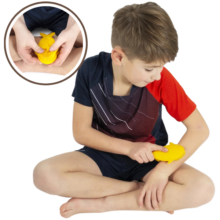Tactile Discrimination
Limited tactile discrimination can impede an individual with special needs from effectively understanding the actions of their hands or body.
Touch perception plays a crucial role in navigating and interpreting physical sensations.
The ability to discern textures and shapes serves as foundational building blocks for learning.
Research indicates that touch perception significantly influences both the speed and legibility of handwriting.
For optimal control of a pencil and accurate letter formation, the brain relies on precise tactile and proprioceptive input from the fingers.
Children experiencing challenges in touch perception may exhibit clumsiness when handling small or delicate objects.
Additionally, they might tightly grip a pencil as a compensatory measure to enhance their sensory connection with it.
Showing 1–24 of 71 results

























